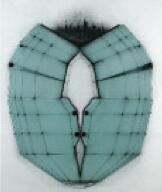Glexis Novoa
Farside, Miami
In Selected works 1998-2001, Glexis Novoa Vian’s (Cuba, 1964) exhibition at Farside Gallery, three works reveal a period of aesthetic transition. In these works, the artist departs from the strategy that characterized his “practical period”, during which, seeking maximum efficacy, he designed a type of monumental works that incarnated the historical relationship between totalitarian governments and the huge dimensions of commemorative architecture, painting and/or sculpture. The installations of those days, concomitant with the Perestroika, were produced in Havana. They parodied the dreams of greatness of the political utopias.

During the artist’s residence in Mexico, there emerged in close contact with the Huastec people a vision of the essential that had an echo in the interest in insect body structures and in organic material such as hair. Color was completely relinquished in Mexico City under the influence of Silvia Gruner,who called Novoa’s attention to the effectiveness of his early urban drawings in graphite.
Waterfall synthesizes Novoa’s geographic, chronological, and aesthetic displacements. It represents his nomadic roamings from Havana to Monterrey, and to Skowhegan, Maine, where he was an artist in residence, through images in graphite on canvas. Each tiered landscape is subject to displacement, attracted by the verti- go of a cascade that draws everything towards a botomless central opening. But instead of aquatic lines there is pubic hair that alludes to “the origin of the world”: it marks the cry of yearning for the return to this origin.
This assimilation between urban and geographic territores and the displaced body is a key element in the piece Untitled, executed in 2001 in the United States, where Novoa began to incorporate metonymic elements related to technology and transportation. For the exhibition “Publickulture”, the artist put his Plymouth 1980 up for sale at the entrance to the Museum of Art in Fort Lauderdale, and he used the windows of this emblematic object of United States culture to install on the wall a sort of aircraft that transported a city. Like all the works that contained allusions to the cities where he had lived in exile, but also the omnipresent traces of Havana. The piece exhibited, made from those same car windows, took advantage of the negative space of the scaffold structure constructed on the canvas to suggest an organic form that is key in his urban fictions. His visual strategy coincides with Spengler’s Decline of the West, regarding the notion that empires, like natural organisms, are subject to destruction, and that every powerful civilization ends up in the shadows. The allusion to latent catastrophes is linked to a post utopia art which does not only mistrust absolutism but also announces the fragility of global powers. Two years before 9/11, in the work titled Área 212 (an allusion to New York’s telephone numbers) Novoa recreated iconographies of the collapse of the most influential cities. In this decade, his small cities in graphite on marble, where threatening peepholes or vigilant balloons keep watch, continue to assault the rhetoric of power that decades before he had de constructed with great installations and ostentatious pictorial gestures. Glexis Novoa evades the confinement of monolithic blocks in the visions of the world.





